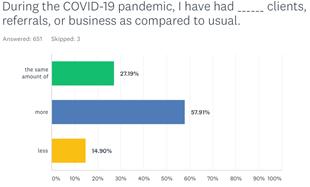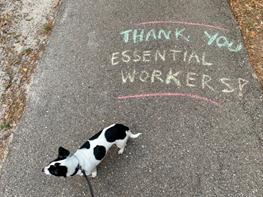
9 minute read
Counseling Tips: Counseling During a Pandemic
In October 2020, Vanessa Lane, LMHC of Massachusetts posted a short and simple message on AMHCA’s Open Forum expressing that her “practice is full to the eye-teeth” and asking her peers, “Is it really busy where you are, too?”
I had been wondering the same thing. At the time, I was working five-to-six days a week, sometimes seeing more than 40 clients in a week, and I was still booked out about six weeks despite having stopped accepting any new referrals. The other counselors in my group practice were having similar experiences, and I was hearing similar experiences from other clinical mental health counselors (CMHCs) across the country.

As more and more AMHCA members started responding to Vanessa’s question, we decided to create and launch a survey in the forum. To my surprise, 654 AMHCA members responded! Here are some of the key findings:
58 % of members said they had more referrals than usual (27 % said they had the same amount of business as usual, and 15 % said they had less as compared to usual). 36 % of members said they were expanding their hours of availability to try and meet the increased demand for therapy. 27 % were limiting new referrals, 26 % were referring to other CMHCs more than usual, 11 % stopped accepting any new referrals, and 8 % hired additional staff to try and address referral increases. 63 % of CMHCs agreed with the statement, “I have reason to believe that clients in my geographical area are finding it hard to find a counselor/therapist. ” 39 % of CMHCs agreed with the statement, “Because of an increase in workload, I am finding it difficult to see my clients as frequently as I/they would like. ” 35 % of CMHCs provided telehealth services prior to the pandemic as compared to 95 % during the pandemic, representing a 3-fold increase in telehealth services. 40 % of CMHCs were providing telehealth only, suspending any in-person sessions. The average counselor estimated that 68 % of sessions were conducted via telehealth vs. inperson.
In addition to highlighting how the pandemic caused a shift towards telehealth, the survey illustrated that during a time of unprecedented stress and we CMHCs were working harder than we ever had.
In 2020, the COVID-19 pandemic ushered in a mental health crisis the likes of which most of us have not seen in a lifetime, including substantial rises in substance use and drug overdoses, clinical depression and anxiety, domestic violence, and suicide. A January 2021 survey conducted by OnePoll found that 1 out of every 6 Americans sought therapy for the first time in 2021, joining the 1 out of every 3 Americans who saw a therapist at some point during the year.
Over the course of this pandemic, I’ve tried to infuse research and clinical experience to generate a list of seven tips and strategies, some of which I’m hoping you might find helpful.
Tip #1: Not All Precautions are Reasonable
Many clients with Obsessive-Compulsive Disorder (OCD) and various anxiety disorders struggle to determine whether the precautions they are taking to avoid COVID-19 infection are healthy or pathological. There’s a big difference between a client who wears a face mask when going to the grocery store and a client who never leaves his home and spends three hours applying a complicated and repetitive purification ritual using multiple chemicals and various UV-C light configurations before opening his package from Amazon.
On one hand, we CMHCs are tasked with treating OCD, often through exposure and response prevention protocols. On the other hand, we aren’t physicians or biomedical scientists, and we don’t want to give our clients terrible advice that opens them up to infection (while possibly opening us up to malpractice liability). approach has been to assist clients with creating a set of standards, often in writing, that uses the recommendations offered by the Centers for Disease Control and Prevention (CDC), World Health Organization (WHO), and International OCD Foundation. If a client wants a little extra reassurance, I suggest reviewing the checklist with their primary care physician to ensure the precautions listed are reasonable but not overkill. This checklist serves as a rubric for separating reasonable precautions from OCD rituals.
Tip #2: Social Distancing Doesn’t Mean Social Isolation
Social distancing is defined by the CDC as “keeping a safe space between yourself and other people who are not from your household. ” This “safe space” is defined as “at least 6 feet. ” Since most people with COVID-19 were infected when in close proximity to someone carrying the virus, social distancing is an essential precaution. On the other hand, social isolation has been connected to its own set of problems, such as damage to areas of the prefrontal cortex in children, higher mortality rates among seniors, physical inflammation, depression, heightened risk of heart disease and stroke, immune system impairment, and a wide range of elevated psychiatric symptoms among the elderly.
Go for a walk in the park or neighborhood, join an outdoor yoga or tai chi group, have conversations, or eat meals outdoors with others while maintaining greater than 6 feet of space on all sides; Use Skype, Zoom, FaceTime, or other technologies to talk with others through webcam; Play multiplayer games (especially ones where you can talk to and collaborate with others) on a console, computer, or mobile device; Purchase a virtual reality headset and use it to attend comedy clubs, board game nights, concerts, nature treks, group workouts, or other social events with friends, family, and others around the world
On Easter morning, while my county was on lockdown, I went for a walk in my neighborhood park. I was delighted and touched to find that children, teens, and adults woke up early and wrote dozens of inspirational messages in chalk on the sidewalks. I never came within six feet of anyone in the park that day, but I know I wasn’t alone.
Tip #3: No Gym Doesn’t Mean No Exercise
We know that exercise enhances mood and strengthens the brain. Some of my clients stopped exercising during the pandemic, lamenting the loss of their access to the gym or to contact sports.Others started, diversified, or expanded their workout regimens during the pandemic, and you can guess which group seems to have maintained a more euthymic mood.
Examples of exercise that can be accessed with little or no equipment while social distancing include core training, aerobics, swimming, jump rope, yoga, calisthenics, resistance training, and running/jogging/walking. Technology paves the way for other options, some pricier than others. I burn about 500 calories with just 30 minutes of boxing with my Oculus Quest 2 virtual reality headset, and it’s way more fun than boxing without one. I’ve had a few clients purchase The Mirror or a Peloton, innovative equipment that allows you to participate in a variety of workout classes and regimens. Apple recently launched Apple Fitness + , Nintendo has the Wii Fit and RingFit, and the list goes on and on. Clients can also Google phrases like “home workouts” and watch video tutorials online.
Tip #4: Make Your Quarantine a Personal Renaissance
Remember all those things you used to do or planned to do but never seem to get around to actually doing? Now’s your chance! I haven’t played baseball in years, but I got a baseball glove, a bucket of balls, and a pitching net and shook the dust off my arms. I read some of those books from my Kindle library that I never seem to get around to. Did you see those heart-warming videos of Italians signing in the balconies during quarantine?

I ask my clients, “What would you do if you had plenty of time on your hands?” Many of my clients got back into painting, drawing, sculpting, coloring, writing or playing music, reading, signing, writing, learning foreign languages, gardening, knitting, and a host of other enjoyable pastimes. For those who struggle to come up with ideas, a Google search with keywords such as “stuff to do” or “list of hobbies” might help generate ideas.

Tip #5: Make Telehealth Fun and Rewarding
“Zoom fatigue” hit me pretty quickly. Day 1 of telehealth sessions was pretty boring. My eyelids were getting heavy. I was getting bored, and I knew I’d need to spice things up. I bought a standing desk and started doing my sessions on my feet. I noticed my energy level rising. I also found that I really liked using screensharing to collaborate with my clients on genograms, cost-benefit analyses, decisional balances, thought records, art therapy, and session notes and treatments plans. I sometimes play short video clips for my clients that illustrate concepts we’re exploring. I played a mobile game for kids with a client to practice CBT skills. I got a digital photo frame and put it next to my computer so that photos of nature and quotes from the heroes who inspire me were constantly cycling by. I use an oil diffuser for aromatherapy filled with my favorite scents.
Tip #6: New Routine Trumps No Routine
Towards the beginning of the pandemic, I noticed that while some of my clients were starting to decomp, others were improving. I studied them closely to see if I could find out what they were doing differently. I found that my clients who were doing the worst had not managed to replace their disrupted routines with new ones. They seemed aimless, and I thought they could use the power of routine. I devised an electronic tool called a “Daily Plan” that prompts clients to sit down each morning and come up with at least one commitment for the day in each of the following categories:
Something productive (i.e., gives you a sense of accomplishment, contribution, or success); Something physical (i.e., a minimum of 2030 minutes of mild, moderate, or intense exercise); Something social (i.e., involves interaction with others while still social distancing); Something meaningful (i.e., gives you a sense of value or purpose); Something entertaining (i.e., is fun, interesting, and/or engaging); Something relaxing (i.e., helps you to destress, relax, or unwind).
My intention was to help clients develop wellrounded routines. I explained to them that at the end of a day in which they did at least one thing in each category, they would likely be able to say to themselves, “This was a day welllived. ” I found that clients who used this tool often reported an improved mood.
Tip #7: Counselor, Health Thyself!
This one’s the simplest tip on my list, but it’s not the easiest one. Take your own advice. Do what you’re trying to help your clients do. Ask yourself, “If my client were experiencing this, what would I think would be good for them?” Then ask yourself, “Am I doing that myself? If not, why?” We must see clearly if we are to yield the torch for our clients as they find their way through these darker times.
Written By: Aaron Norton, LMHC
Aaron Norton is a Licensed Mental Health Counselor and Licensed Marriage and Family Therapy serving as Executive Director of the National Board of Forensic Evaluators, Adjunct Instructor at the University of South Florida, Southern Regional Director for the American Mental Health Counselors Association, and PastPresident of the Florida Mental Health Counselors Association. He has nearly 20 years of clinical and forensic experience at Integrity Counseling, Inc., was awarded Mental Health Counselor of the Year by the American Mental Health Counselors Association and Counselor Educator of the Year by the Florida Mental Health Counselors Association in 2016, Researcher of the Year by Florida Mental Health Counselors Association in 2020, and has been published in several social science journals and professional magazines in clinical mental health counseling.










